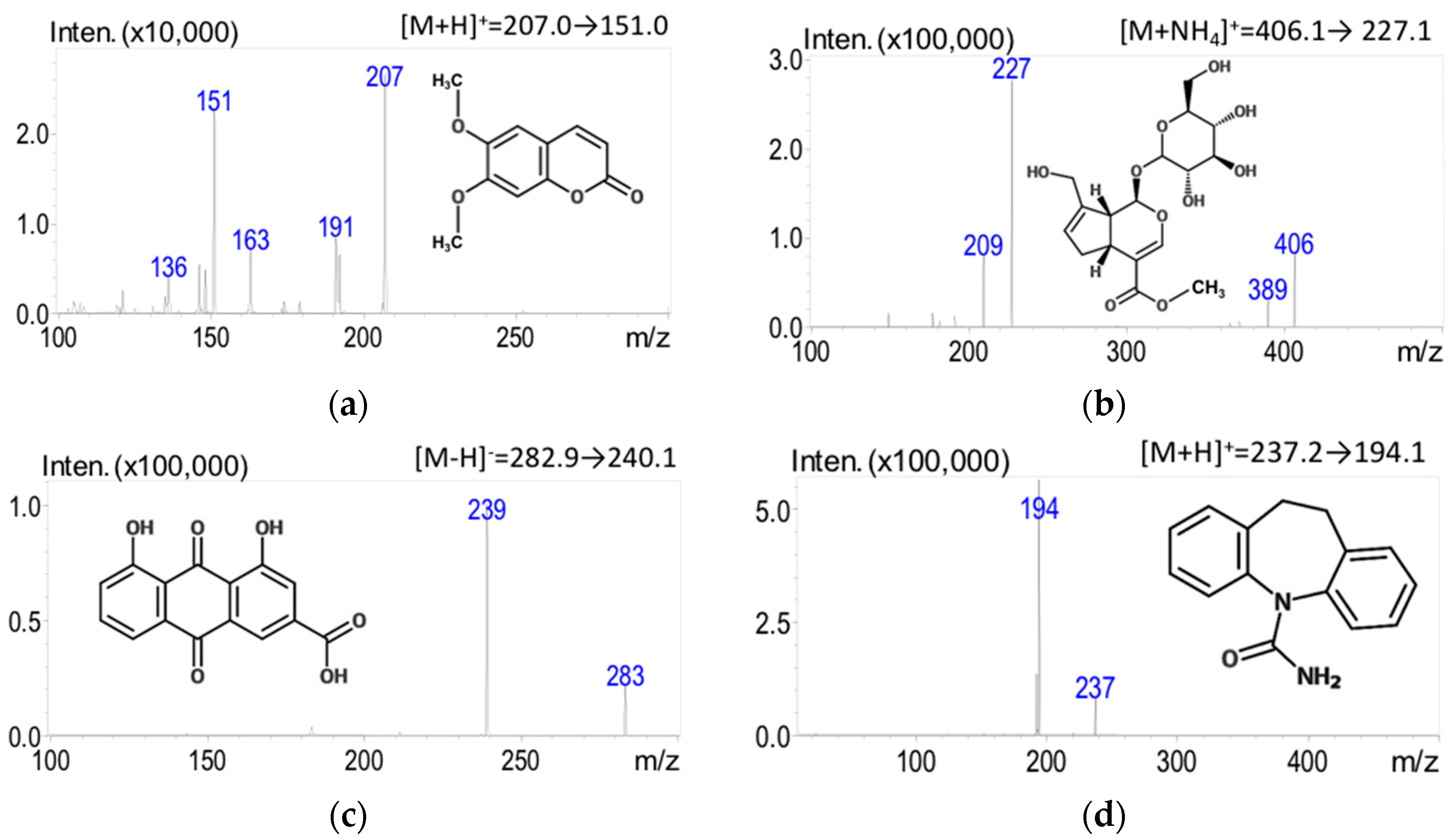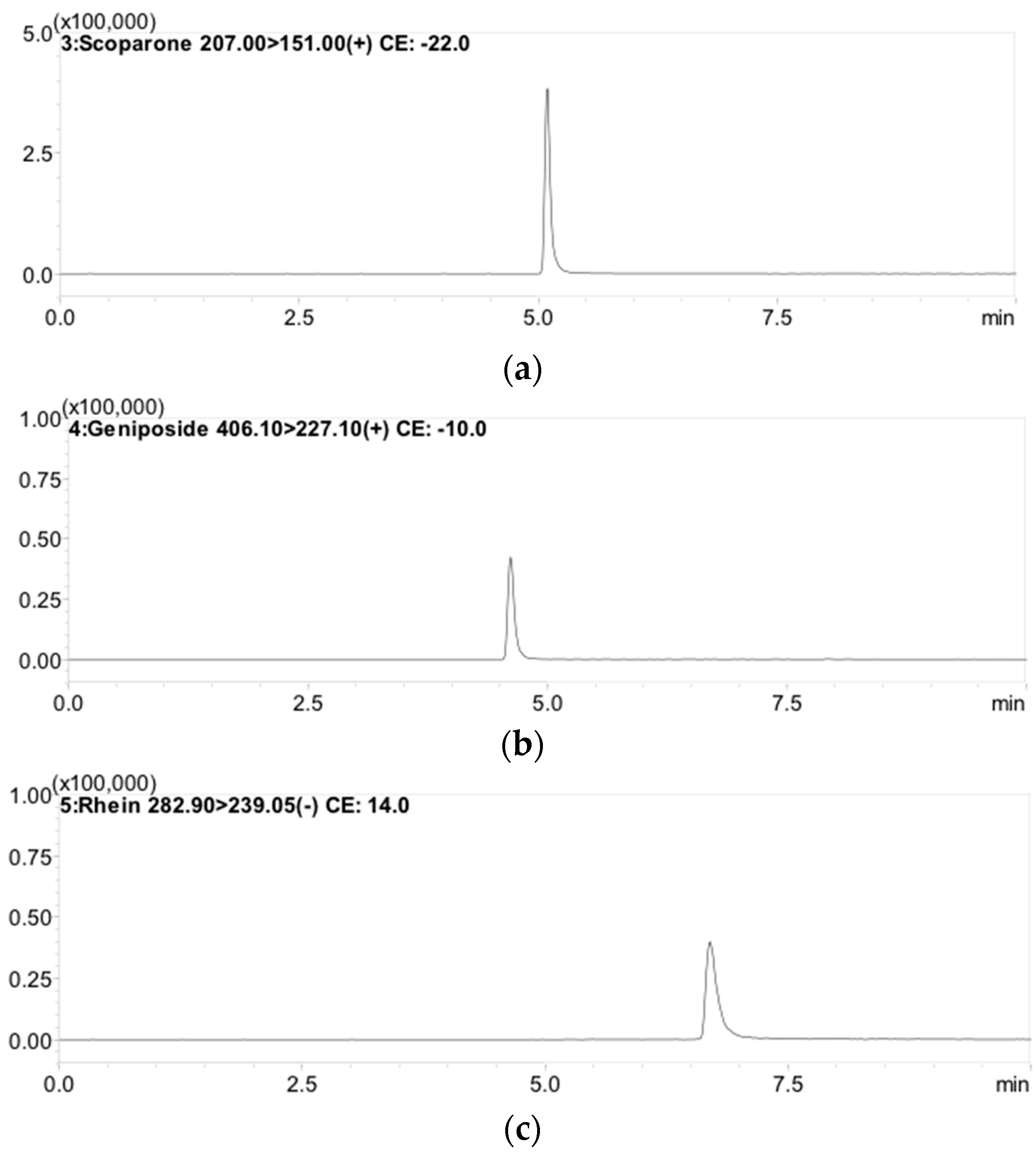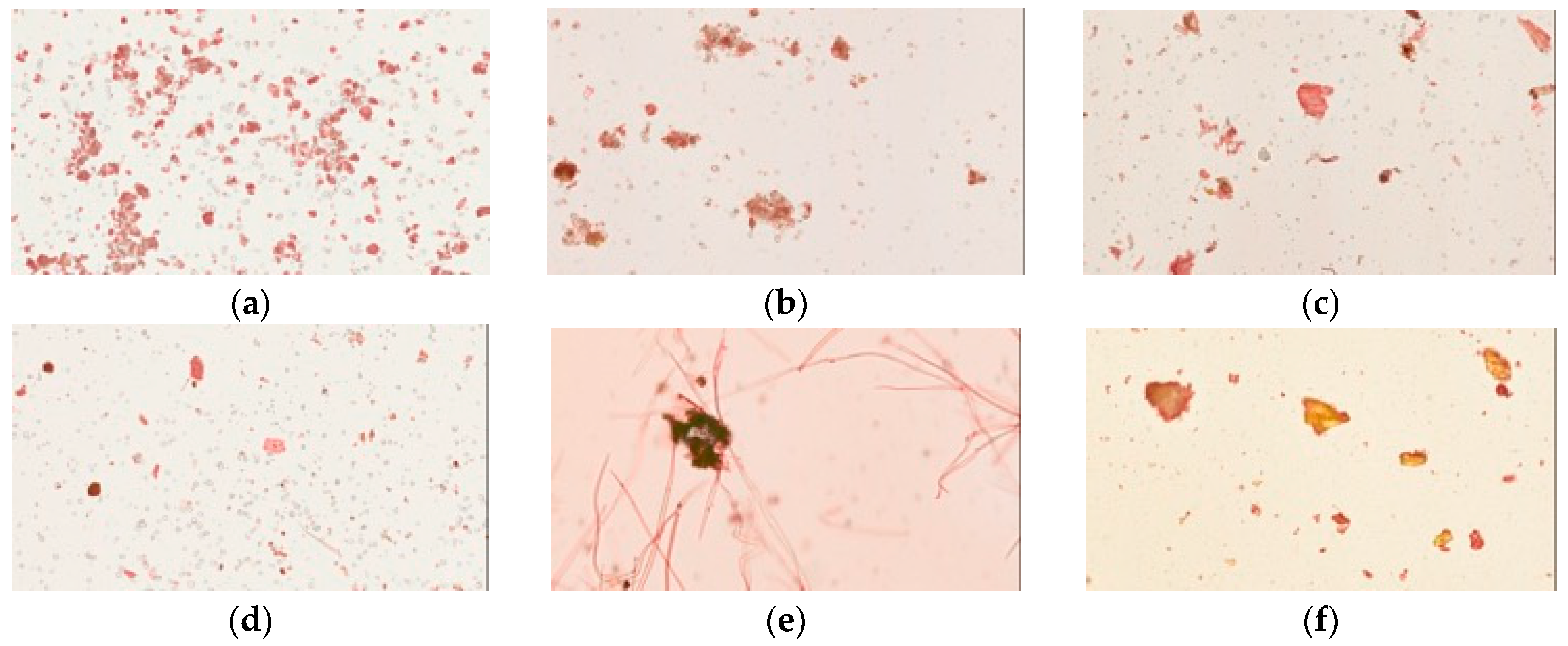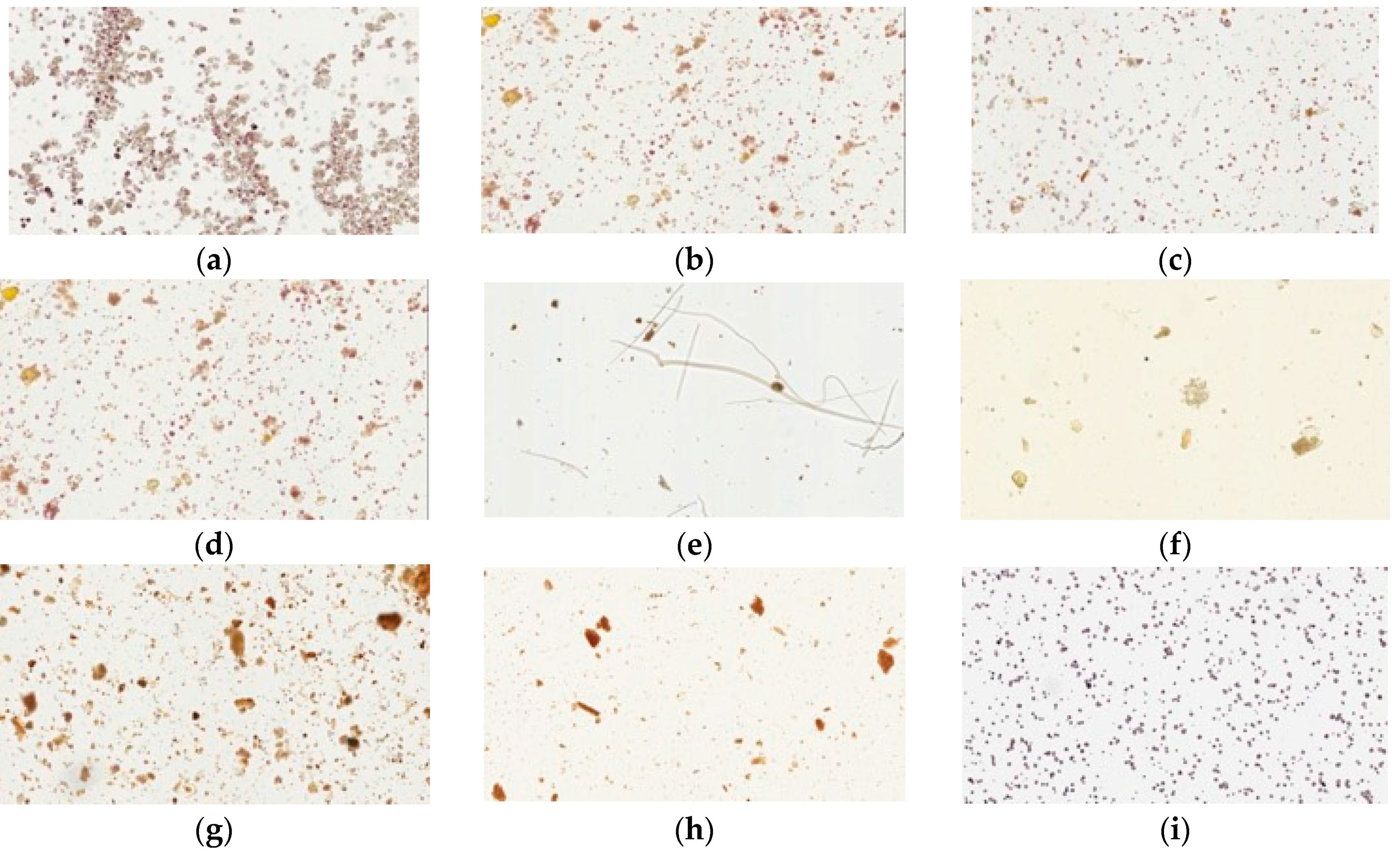Using Light Microscopy and Liquid Chromatography Tandem Mass Spectrometry for Qualitative and Quantitative Control of a Combined Three-Herb Formulation in Different Preparations
Abstract
:1. Introduction
2. Results
2.1. Optimization of LC-MS/MS Conditions
2.2. Method Validation
2.3. Light Microscopy Photographs of Congo Red and Iodine Staining
2.4. Quantitative Determination of the Three Marker Compounds of YCHT Preparations
3. Discussion
4. Materials and Methods
4.1. Reagents
4.2. Instrumentation and Software
4.3. High-Performance Liquid Chromatography Separation and Tandem Mass Spectrometry Detection
4.4. Stock and Working Solutions
4.5. Sample Preparation for Extracts of Pharmaceutical Products and the Decoction
4.6. Analytical Method Validation
4.7. Light Microscopy Photographs of Congo Red- and Iodine-Stained Samples
5. Conclusions
Acknowledgments
Author Contributions
Conflicts of Interest
References
- Shi, Z.; Li, Z.; Zhang, S.; Fu, H.; Zhang, H. Subzero-temperature liquid-liquid extraction coupled with UPLC-MS-MS for the simultaneous determination of 12 bioactive components in traditional Chinese medicine gegen-qinlian decoction. J. Chromatogr. Sci. 2015, 53, 1407–1413. [Google Scholar] [CrossRef] [PubMed]
- Wang, Y.; Xu, R.; Xiao, J.; Zhang, J.; Wang, X.; An, R.; Ma, Y. Quantitative analysis of flavonoids, alkaloids and saponins of Banxia Xiexin decoction using ultra-high performance liquid chromatography coupled with electrospray ionization tandem mass spectrometry. J. Pharm. Biomed. Anal. 2014, 88, 525–535. [Google Scholar] [CrossRef] [PubMed]
- Hou, M.L.; Chang, L.W.; Lin, C.H.; Lin, L.C.; Tsai, T.H. Determination of bioactive components in Chinese herbal formulae and pharmacokinetics of rhein in rats by UPLC-MS/MS. Molecules 2014, 19, 4058–4075. [Google Scholar] [CrossRef] [PubMed]
- Wang, P.; Wang, B.; Xu, J.; Sun, J.; Yan, Q.; Ji, B.; Zhao, Y.; Yu, Z. Detection and chemical profiling of Ling-Gui-Zhu-Gan decoction by ultra performance liquid chromatography-hybrid linear ion trap-orbitrap mass spectrometry. J. Chromatogr. Sci. 2015, 53, 263–273. [Google Scholar] [CrossRef] [PubMed]
- Jang, S.I.; Kim, Y.J.; Lee, W.Y.; Kwak, K.C.; Baek, S.H.; Kwak, G.B.; Yun, Y.G.; Kwon, T.O.; Chung, H.T.; Chai, K.Y. Scoparone from artemisia capillaris inhibits the release of inflammatory mediators in RAW 264.7 cells upon stimulation cells by interferon-gamma Plus LPS. Arch. Pharm. Res. 2005, 28, 203–208. [Google Scholar] [CrossRef] [PubMed]
- Kim, K.S.; Yang, H.J.; Lee, J.Y.; Na, Y.C.; Kwon, S.Y.; Kim, Y.C.; Lee, J.H.; Jang, H.J. Effects of beta-sitosterol derived from artemisia capillaris on the activated human hepatic stellate cells and dimethylnitrosamine-induced mouse liver fibrosis. BMC Complement. Altern. Med. 2014, 14, 363. [Google Scholar] [CrossRef] [PubMed]
- Koo, H.J.; Lee, S.; Shin, K.H.; Kim, B.C.; Lim, C.J.; Park, E.H. Geniposide, an anti-angiogenic compound from the fruits of Gardenia jasminoides. Planta Med. 2004, 70, 467–469. [Google Scholar] [PubMed]
- Koo, H.J.; Lim, K.H.; Jung, H.J.; Park, E.H. Anti-inflammatory evaluation of gardenia extract, geniposide and genipin. J. Ethnopharmacol. 2006, 103, 496–500. [Google Scholar] [CrossRef] [PubMed]
- Kim, J.; Kim, H.Y.; Lee, S.M. Protective effects of geniposide and genipin against hepatic ischemia/reperfusion injury in mice. Biomol. Ther. 2013, 21, 132–137. [Google Scholar] [CrossRef] [PubMed]
- Tang, J.C.; Yang, H.; Song, X.Y.; Song, X.H.; Yan, S.L.; Shao, J.Q.; Zhang, T.L.; Zhang, J.N. Inhibition of cytochrome p450 enzymes by rhein in rat liver microsomes. Phytother. Res. 2009, 23, 159–164. [Google Scholar] [CrossRef] [PubMed]
- Chen, Y.Y.; Chiang, S.Y.; Lin, J.G.; Ma, Y.S.; Liao, C.L.; Weng, S.W.; Lai, T.Y.; Chung, J.G. Emodin, aloe-emodin and rhein inhibit migration and invasion in human tongue cancer SCC-4 cells through the inhibition of gene expression of matrix metalloproteinase-9. Int. J. Oncol. 2010, 36, 1113–1120. [Google Scholar] [PubMed]
- Peng, S.N.; Zeng, H.H.; Fu, A.X.; Chen, X.W.; Zhu, Q.X. Effects of rhein on intestinal epithelial tight junction in IgA nephropathy. World J. Gastroenterol. 2013, 19, 4137–4145. [Google Scholar] [CrossRef] [PubMed]
- Cong, X.D.; Ding, M.J.; Dai, D.Z.; Wu, Y.; Zhang, Y.; Dai, Y. ER stress, P66shc, and p-Akt/Akt mediate adjuvant-induced inflammation, which is blunted by argirein, a supermolecule and rhein in rats. Inflammation 2012, 35, 1031–1040. [Google Scholar] [CrossRef] [PubMed]
- Zhong, X.F.; Huang, G.D.; Luo, T.; Deng, Z.Y.; Hu, J.N. Protective effect of rhein against oxidative stress-related endothelial cell injury. Mol. Med. Rep. 2012, 5, 1261–1266. [Google Scholar] [PubMed]
- Yu, L.; Xiang, H.; Fan, J.; Wang, D.; Yang, F.; Guo, N.; Jin, Q.; Deng, X. Global transcriptional response of Staphylococcus aureus to rhein, a natural plant product. J. Biotechnol. 2008, 135, 304–308. [Google Scholar] [CrossRef] [PubMed]
- Wang, X.; Lv, H.; Sun, H.; Liu, L.; Yang, B.; Sun, W.; Wang, P.; Zhou, D.; Zhao, L.; Dou, S.; et al. Metabolic urinary profiling of alcohol hepatotoxicity and intervention effects of Yin Chen Hao Tang in rats using ultra-performance liquid chromatography/electrospray ionization quadruple time-of-flight mass spectrometry. J. Pharm. Biomed. Anal. 2008, 48, 1161–1168. [Google Scholar] [CrossRef] [PubMed]
- Wang, X.; Sun, W.; Sun, H.; Lv, H.; Wu, Z.; Wang, P.; Liu, L.; Cao, H. Analysis of the constituents in the rat plasma after oral administration of Yin Chen Hao Tang by UPLC/Q-TOF-MS/MS. J. Pharm. Biomed. Anal. 2008, 46, 477–490. [Google Scholar] [CrossRef] [PubMed]
- Lee, T.Y.; Chang, H.H.; Chen, J.H.; Hsueh, M.L.; Kuo, J.J. Herb medicine Yin-Chen-Hao-Tang ameliorates hepatic fibrosis in bile duct ligation rats. J. Ethnopharmacol. 2007, 109, 318–324. [Google Scholar] [CrossRef] [PubMed]
- Lee, T.Y.; Chang, H.H.; Wu, M.Y.; Lin, H.C. Yin-Chen-Hao-Tang ameliorates obstruction-induced hepatic apoptosis in rats. J. Pharm. Pharmacol. 2007, 59, 583–590. [Google Scholar] [CrossRef] [PubMed]
- Lee, T.Y.; Chang, H.H.; Lo, W.C.; Lin, H.C. Alleviation of hepatic oxidative stress by Chinese herbal medicine Yin-Chen-Hao-Tang in obese mice with steatosis. Int. J. Mol. Med. 2010, 25, 837–844. [Google Scholar] [CrossRef] [PubMed]
- Cheng, H.Y.; Lin, L.T.; Huang, H.H.; Yang, C.M.; Lin, C.C. Yin Chen Hao Tang, a Chinese prescription, inhibits both herpes simplex virus type-1 and type-2 infections in vitro. Antiviral. Res. 2008, 77, 14–19. [Google Scholar] [CrossRef] [PubMed]
- Zhang, H.; Wang, X.; Hu, P.; Zhou, W.; Zhang, M.; Liu, J.; Wang, Y.; Liu, P.; Luo, G. Serum metabolomic characterization of liver fibrosis in rats and anti-fibrotic effects of Yin-Chen-Hao-Tang. Molecules 2016, 21, 126. [Google Scholar] [CrossRef] [PubMed]
- Samim, M.; Sandkuijl, D.; Tretyakov, I.; Cisek, R.; Barzda, V. Differential polarization nonlinear optical microscopy with adaptive optics controlled multiplexed beams. Int. J. Mol. Sci. 2013, 14, 18520–18534. [Google Scholar] [CrossRef] [PubMed]
- Bailey, J.M.; Whelan, W.J. Physical properties of starch. I. Relationship between iodine stain and chain length. J. Biol. Chem. 1961, 236, 969–973. [Google Scholar] [PubMed]
- Wang, X.; Lv, H.; Sun, H.; Liu, L.; Sun, W.; Cao, H. Development of a rapid and validated method for investigating the metabolism of scoparone in rat using ultra-performance liquid chromatography/electrospray ionization quadruple time-of-flight mass spectrometry. Rapid Commun. Mass Spectrom. 2007, 21, 3883–3890. [Google Scholar] [CrossRef] [PubMed]
- Wang, S.-C.; Huang, C.-M.; Tsai, T.-H. Determinations of geniposide using LC/MS/MS methods via forming ammonium and acetate adducts. Microchem. J. 2007, 86, 174–182. [Google Scholar] [CrossRef]
- Wang, Y.; Fan, R.; Luo, J.; Tang, T.; Xing, Z.; Xia, Z.; Peng, W.; Wang, W.; Lv, H.; Huang, W.; et al. An ultra high performance liquid chromatography with tandem mass spectrometry method for plasma and cerebrospinal fluid pharmacokinetics of rhein in patients with traumatic brain injury after administration of rhubarb decoction. J. Sep. Sci. 2015, 38, 1100–1108. [Google Scholar] [CrossRef] [PubMed]
- Pan, I.H.; Chiu, H.H.; Lu, C.H.; Lee, L.T.; Li, Y.K. Aqueous two-phase extraction as an effective tool for isolation of geniposide from gardenia fruit. J. Chromatogr. A 2002, 977, 239–246. [Google Scholar] [CrossRef]
- Tsai, T.R.; Tseng, T.Y.; Chen, C.F.; Tsai, T.H. Identification and determination of geniposide contained in Gardenia jasminoides and in two preparations of mixed traditional Chinese medicines. J. Chromatogr. A 2002, 961, 83–88. [Google Scholar] [CrossRef]
- Peter, K.; Schinnerl, J.; Felsinger, S.; Brecker, L.; Bauer, R.; Breiteneder, H.; Xu, R.; Ma, Y. A novel concept for detoxification: complexation between aconitine and liquiritin in a Chinese herbal formula (‘Sini Tang’). J. Ethnopharmacol. 2013, 149, 562–569. [Google Scholar] [CrossRef] [PubMed]
- Zhang, A.; Sun, H.; Yuan, Y.; Sun, W.; Jiao, G.; Wang, X. An in vivo analysis of the therapeutic and synergistic properties of Chinese medicinal formula Yin-Chen-Hao-Tang based on its active constituents. Fitoterapia 2011, 82, 1160–1168. [Google Scholar] [CrossRef] [PubMed]
- Tsang, S.W.; Bian, Z.X. Anti-fibrotic and anti-tumorigenic effects of rhein, a natural anthraquinone derivative, in mammalian stellate and carcinoma cells. Phytother. Res. 2015, 29, 407–414. [Google Scholar] [CrossRef] [PubMed]
- Wang, X.; Lv, H.; Sun, H.; Jiang, X.; Wu, Z.; Sun, W.; Wang, P.; Liu, L.; Bi, K. Quality evaluation of Yin Chen Hao Tang extract based on fingerprint chromatogram and simultaneous determination of five bioactive constituents. J. Sep. Sci. 2008, 31, 9–15. [Google Scholar] [CrossRef] [PubMed]
- Food and Drug Administration Center for Drug Evaluation and Research. Guidance for Industry: Bioanalytical Method Validation. Food and Drug Administration: Rockville, MD, United States, 2001. Available online: http://www.fda.gov/downloads/drugs/guidancecomplianceregulatoryinformation/guidances/ucm368107.pdf2007 (accessed on 8 November 2016). [Google Scholar]
- Sample Availability: Not Available.





| Constituents | Molecular Weight | RT 1 (min) | Mass Fragments | Collision Energy (eV) | |
|---|---|---|---|---|---|
| Q1 Mass (amu) | Q3 Mass (amu) | ||||
| Scoparone | 206.20 | 5.3 | 207.0 [M + H]+ | 151.0 | −22 |
| Geniposide | 388.36 | 4.7 | 406.1 [M + NH4]+ | 227.1 | −10 |
| Rhein | 284.22 | 6.9 | 282.9 [M − H]− | 240.15 | 14 |
| Carbamazepine (IS) 2 | 236.26 | 5.8 | 237.2 [M + H]+ | 194.1 | −20 |
| Constituents | Linear Range (ng/mL) | Calibration Curve | R2 | LOD (ng/mL) |
|---|---|---|---|---|
| Scoparone | 1–100 | y = 15466x − 1167.7 | 0.996 | 0.5 |
| Geniposide | 5–1000 | y = 2036.7x − 2543.7 | 0.999 | 1 |
| Rhein | 5–500 | y = 3198.3x + 838.43 | 0.997 | 1 |
| Nominal Conc. (ng/mL) | Intra-Day | Inter-Day | ||||
|---|---|---|---|---|---|---|
| Observed Conc. (ng/mL) | Precision, RSD (%) | Accuracy, Bias (%) | Observed Conc. (ng/mL) | Precision, RSD (%) | Accuracy, Bias (%) | |
| Scoparone | ||||||
| 1 | 1.02 ± 0.14 | 14.08 | 1.79 | 1.03 ± 0.13 | 12.40 | 3.12 |
| 5 | 5.02 ± 0.49 | 9.78 | 0.32 | 5.20 ± 0.64 | 12.31 | 3.94 |
| 10 | 10.08 ± 0.77 | 7.65 | 0.81 | 10.40 ± 1.04 | 10.02 | 4.02 |
| 50 | 50.94 ± 3.50 | 6.87 | 1.89 | 51.91 ± 4.45 | 8.57 | 3.82 |
| 100 | 99.39 ± 4.71 | 4.74 | –0.61 | 98.12 ± 3.49 | 3.56 | –1.88 |
| Geniposide | ||||||
| 5 | 5.49 ± 0.25 | 4.53 | 9.83 | 5.57 ± 0.34 | 6.09 | 11.31 |
| 10 | 9.95 ± 0.46 | 4.61 | –0.54 | 10.17 ± 0.55 | 5.45 | 1.73 |
| 50 | 48.91 ± 1.17 | 2.40 | –2.18 | 49.93 ± 1.63 | 3.26 | –0.13 |
| 100 | 101.32 ± 3.08 | 3.04 | 1.32 | 100.35 ± 2.98 | 2.97 | 0.35 |
| 500 | 501.13 ± 18.27 | 3.64 | 0.23 | 519.20 ± 25.51 | 4.91 | 3.84 |
| 1000 | 1090.58 ± 44.58 | 4.09 | 9.06 | 1107.45 ± 43.45 | 3.92 | 10.74 |
| Rhein | ||||||
| 5 | 5.05 ± 0.43 | 8.43 | 0.95 | 4.53 ± 0.29 | 6.45 | –9.34 |
| 10 | 9.39 ± 0.74 | 7.93 | –6.10 | 9.92 ± 0.41 | 4.13 | –0.84 |
| 50 | 50.57 ± 4.25 | 8.41 | 1.15 | 53.08 ± 6.22 | 11.72 | 6.17 |
| 100 | 99.17 ± 1.67 | 1.69 | –0.83 | 103.37 ± 4.28 | 4.14 | 3.37 |
| 500 | 423.21 ± 9.03 | 2.13 | –15.36 | 492.91 ± 63.74 | 12.93 | –1.42 |
| Compound | Scoparone (mg/g) | Geniposide (mg/g) | Rhein (mg/g) | |||
|---|---|---|---|---|---|---|
| Brands | Water 1 | Ethanol 2 | Water 1 | Ethanol 2 | Water 1 | Ethanol 2 |
| A | 0.268 ± 0.01 | 0.177 ± 0.09 | 6.362 ± 0.200 | 1.419 ± 0.120 | 0.092 ± 0.002 | 0.123 ± 0.003 |
| B | 0.207 ± 0.006 | 0.162 ± 0.041 | 7.241 ± 0.139 | 1.033 ± 0.254 | 0.093 ± 0.002 | 0.187 ± 0.049 |
| C | ND | ND | 8.972 ± 0.436 | 1.968 ± 0.414 | 0.040 ± 0.002 | 0.043 ±0.011 |
| D | ND | ND | 0.840 ± 0.046 | 0.984 ± 0.204 | 0.045 ± 0.002 | 0.135 ± 0.031 |
| Art. | ND | ND | ND | ND | ND | ND |
| Gar. | ND | ND | 5.288 ± 1.023 | 19.195 ± 2.461 | ND | ND |
| Rhe. | ND | ND | ND | ND | 0.0137 ± 0.006 | 0.996 ± 0.071 |
| Decoction 3 | ND | 36.068 ± 0.553 | 4.416 ± 0.20 | |||
© 2016 by the authors. Licensee MDPI, Basel, Switzerland. This article is an open access article distributed under the terms and conditions of the Creative Commons Attribution (CC-BY) license ( http://creativecommons.org/licenses/by/4.0/).
Share and Cite
Hsueh, T.-P.; Lin, W.-L.; Tsai, T.-H. Using Light Microscopy and Liquid Chromatography Tandem Mass Spectrometry for Qualitative and Quantitative Control of a Combined Three-Herb Formulation in Different Preparations. Molecules 2016, 21, 1673. https://doi.org/10.3390/molecules21121673
Hsueh T-P, Lin W-L, Tsai T-H. Using Light Microscopy and Liquid Chromatography Tandem Mass Spectrometry for Qualitative and Quantitative Control of a Combined Three-Herb Formulation in Different Preparations. Molecules. 2016; 21(12):1673. https://doi.org/10.3390/molecules21121673
Chicago/Turabian StyleHsueh, Tun-Pin, Wan-Ling Lin, and Tung-Hu Tsai. 2016. "Using Light Microscopy and Liquid Chromatography Tandem Mass Spectrometry for Qualitative and Quantitative Control of a Combined Three-Herb Formulation in Different Preparations" Molecules 21, no. 12: 1673. https://doi.org/10.3390/molecules21121673
APA StyleHsueh, T.-P., Lin, W.-L., & Tsai, T.-H. (2016). Using Light Microscopy and Liquid Chromatography Tandem Mass Spectrometry for Qualitative and Quantitative Control of a Combined Three-Herb Formulation in Different Preparations. Molecules, 21(12), 1673. https://doi.org/10.3390/molecules21121673







